Name Ocean Ranger Christened 1976 Launched 1976 | Owner ODECO Yard number 615641 Completed 1976 Length 121 m | |
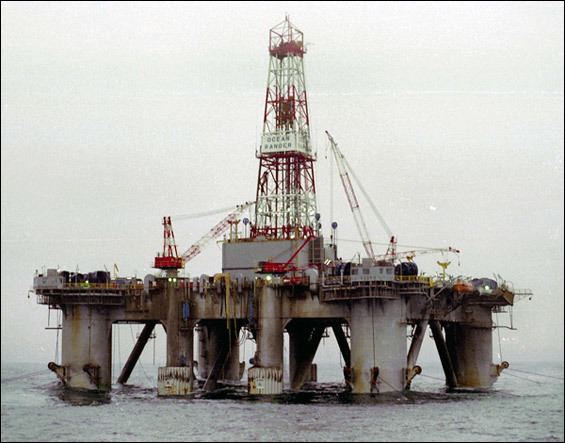 | ||
Builder | ||
Ocean ranger disaster pt 1 of 6
Ocean Ranger was a semi-submersible mobile offshore drilling unit that sank in Canadian waters on 15 February 1982. It was drilling an exploration well on the Grand Banks of Newfoundland, 267 kilometres (166 mi) east of St. John's, Newfoundland, for Mobil Oil of Canada, Ltd. (MOCAN) with 84 crew members on board when it sank. There were no survivors.
Contents
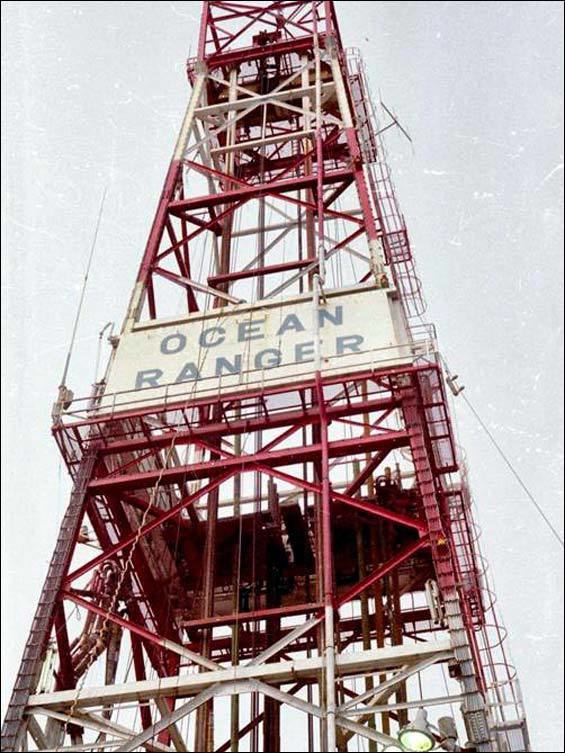
History and design

Ocean Ranger was designed and owned by Ocean Drilling and Exploration Company, Inc. (ODECO) of New Orleans. The vessel was a self-propelled large semi-submersible design with a drilling facility and living quarters. It was capable of operation beneath 1,500 feet (460 m) of ocean water and could drill to a maximum depth of 25,000 feet (7,600 m). It was described by ODECO as the world's largest semi-submersible oil rig to date.
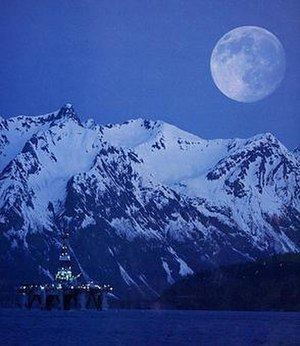
Constructed for ODECO in 1976 by Mitsubishi Heavy Industries in Hiroshima, Japan, Ocean Ranger was 396 feet (121 m) long, 262 feet (80 m) wide, and 337 feet (103 m) high. It had twelve 45,000-pound (20,000 kg) anchors. The weight was 25,000 tons. It was floating on two 122-metre (400 ft) long pontoons that rested 24 metres (79 ft) below the surface.
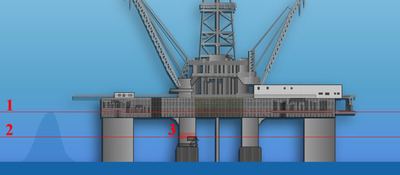
The vessel was approved for 'unrestricted ocean operations' and designed to withstand extremely harsh conditions at sea, including 100-knot (190 km/h) winds and 110-foot (34 m) waves. Prior to moving to the Grand Banks area in November 1980, it had operated off the coasts of Alaska, New Jersey and Ireland.
Sinking
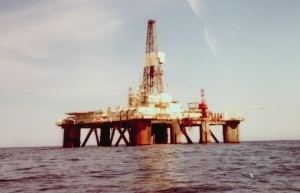
On 26 November 1981, Ocean Ranger commenced drilling well J-34, its third well in the Hibernia Oil Field. Ocean Ranger was still working on this well in February 1982 when the incident occurred. Two other semi-submersible platforms were also drilling nearby: Sedco 706, 8.5 miles (13.7 km) NNE, and Zapata Ugland, 19.2 miles (30.9 km) N of Ocean Ranger. On 14 February 1982, the platforms received reports of an approaching storm linked to a major Atlantic cyclone from NORDCO Ltd, the company responsible for issuing offshore weather forecasts. The usual method of preparing for bad weather involved hanging-off the drillpipe at the sub-sea wellhead and disconnecting the riser from the sub-sea blowout preventer. Due to surface difficulties and the speed at which the storm developed, the crew of Ocean Ranger were forced to shear the drillpipe after hanging-off, after which they disconnected the riser in the early evening.

At about 19:00 local time, the nearby Sedco 706 experienced a large rogue wave which damaged some items on deck and caused the loss of a life raft. Soon after, radio transmissions were heard from Ocean Ranger, describing a broken portlight (a porthole window) and water in the ballast control room, with discussions on how best to repair the damage. Ocean Ranger reported experiencing storm seas of 55 feet (17 m), with the odd wave up to 65 feet (20 m), thus leaving the unprotected portlight at 28 feet (8.5 m) above mean sea level vulnerable to wave damage. Some time after 21:00, radio conversations originating on Ocean Ranger were heard on Sedco 706 and Zapata Ugland, noting that valves on Ocean Ranger's ballast control panel appeared to be opening and closing of their own accord. The radio conversations also discussed the 100-knot (190 km/h) winds and waves up to 65 feet (20 m) high. Through the remainder of the evening, routine radio traffic passed between Ocean Ranger, its neighbouring rigs and their individual support boats. Nothing out of the ordinary was noted.
At 00:52 local time, on 15 February, a Mayday call was sent out from Ocean Ranger, noting a severe list to the port side of the rig and requesting immediate assistance. This was the first communication from Ocean Ranger identifying a major problem. The standby vessel, the M/V Seaforth Highlander, was requested to come in close as countermeasures against the 10–15-degree list were proving ineffective. The onshore MOCAN supervisor was notified of the situation, and the Canadian Forces and Mobil-operated helicopters were alerted just after 1:00 local time. The M/V Boltentor and the M/V Nordertor, the standby boats of Sedco 706 and Zapata Ugland respectively, were also dispatched to Ocean Ranger to provide assistance. At 1:30 local time, Ocean Ranger transmitted its last message: "There will be no further radio communications from Ocean Ranger. We are going to lifeboat stations." Shortly thereafter, in the middle of the night and in the midst of severe winter weather, the crew abandoned the platform. The platform remained afloat for another ninety minutes, sinking between 3:07 and 3:13 local time.
All of Ocean Ranger sank beneath the Atlantic: by the next morning all that remained was a few buoys. Her entire complement of 84 workers – 46 Mobil employees and 38 contractors from various service companies – were killed. While the rig was provided with an Emergency Procedures Manual which detailed evacuation procedures, it is unclear how effectively the platform evacuation was carried out. There is evidence that at least one lifeboat was successfully launched with up to 36 crew inside, and witnesses on the M/V Seaforth Highlander reported seeing at least 20 crew members in the water at the same time, indicating that at least 56 crew successfully evacuated the rig. The United States Coast Guard report speculated that 'these men either chose to enter the water directly or were thrown into the water as a result of unsuccessful lifesaving equipment launching'. Rescue attempts by the standby vessels were hampered by the adverse weather conditions and the conclusion that the standby boats were neither equipped nor configured to rescue casualties from a cold sea. As a result of the severe weather, the first helicopter did not arrive on scene until 2:30 local time, by which time most if not all of Ocean Ranger's crew had succumbed to hypothermia and drowned. Over the next week, 22 bodies were recovered from the North Atlantic. Autopsies indicated that those men had died as a result of drowning while in a hypothermic state.
In related activity the following day, the Soviet container ship Mekhanik Tarasov was struck by the same weather conditions as Ocean Ranger, approximately sixty-five miles to the east. The battered Soviet freighter listed dramatically for hours before sinking with the loss of 32 of 37 crew.
Causes and effects
The remains of the platform were found by sonar search over the following weeks, resting in an inverted position approximately 485 feet (148 m) south-east of the wellhead, surrounded by major items of debris such as the derrick. The platform had capsized bow-first, turning over and striking the sea floor with the forward ends of the platform's pontoons. The United States Coast Guard Marine Board of Investigation report on the disaster summarised the chain of events as follows:
A Canadian Royal Commission spent two years looking into the disaster. The joint Federal-Provincial Royal Commission on the Ocean Ranger Marine Disaster found that the crew were not trained, the safety equipment was inadequate, there were no safety protocols for the supply ship, and that the platform itself had a number of flaws. The Royal Commission concluded that Ocean Ranger had design and construction flaws, particularly in the ballast control room, and that the crew lacked proper safety training, survival suits and equipment. The Royal Commission also concluded that inspection and regulation by United States and Canadian government agencies was ineffective. In addition to key recommendations for Canada's offshore oil and gas industry, the commission recommended that the federal government invest annually in research and development for search and rescue technologies, such as improving the design of lifesaving equipment—a commitment that has been met in every fiscal year since 1982.
Aftermath
In August 1983, the wreck of the Ocean Ranger was refloated and sunk in deeper waters by the dutch firm Wijsmuller Salvage. Since its sinking the previous year, concerns over the wreck's position had been made by the federal government. As the Ocean Ranger was situated at an approximate 30 metres below the water, the wreck posed a danger to shipping. The operation saw the Ocean Ranger towed upside down with its two pontoons breaking the surface.
Operations had commenced earlier in June, however progress was halted when two salvage divers were killed on the wreck by an underwater explosion on 20 June. A stop-work order on refloating the wreck was declared and an investigation into the incident followed. However, exploratory diving was allowed to continue. A second incident on 26 June saw a third diver killed, believed to have been hit by a dropped object as he attempted to return to the surface.
Lawsuits arising from the sinking were settled out of court with a package cumulatively valued at $20 million.
A permanent monument to those who died was created on the grounds of the Confederation Building, the seat of the provincial government of Newfoundland.
A documentary film, The Ocean Ranger Disaster (2002), was released only in Canada. In fiction, Canadian author Lisa Moore's novel, February (2009), depicts the life of a woman whose husband died aboard the oil rig. Canadian folk singer-songwriter Ron Hynes wrote a song called "Atlantic Blue" (1988) as a tribute to the crew of Ocean Ranger.
In January 2012, a non-fiction book, The Ocean Ranger: Remaking the Promise of Oil was published in Canada by Fernwood Publishing. The book's author, Susan Dodd, lost her older brother Jim with the sinking of the Ocean Ranger and watched, for years, as her parents pursued legal struggles with the oil companies.
